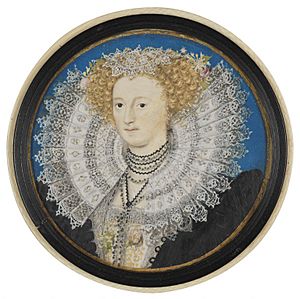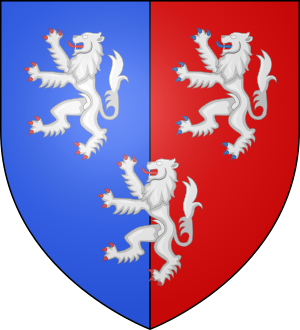Mary Sidney facts for kids
Quick facts for kids
Mary Herbert
|
|
|---|---|

Portrait of Mary Herbert (née Sidney), by Nicholas Hilliard, c. 1590.
|
|
| Countess of Pembroke | |
| Tenure | 19 January 1601 - 19 January 1601 |
| Known for | Literary patron, author |
| Born | 27 October 1561 Tickenhill Palace, Bewdley, England |
| Died | 25 September 1621 London, England |
| Buried | Salisbury Cathedral |
| Noble family | Sidney |
| Spouse(s) | Henry Herbert, 2nd Earl of Pembroke |
| Issue | William Herbert, 3rd Earl of Pembroke Katherine Herbert Anne Herbert Philip Herbert, 4th Earl of Pembroke |
| Father | Henry Sidney |
| Mother | Mary Dudley |
Mary Herbert, also known as Mary Sidney, was an important English writer and supporter of other writers. She was born on October 27, 1561, and passed away on September 25, 1621. She was one of the first English women to become famous for her poems and for helping other authors.
When she was 39, Mary was listed among the best writers of her time. This list included her brother Philip Sidney, Edmund Spenser, and William Shakespeare. Her play Antonius helped bring back a type of speech called "soliloquy" in plays. It also likely inspired Shakespeare's famous play Antony and Cleopatra. Mary was also known for translating poems, especially a beautiful version of the Psalms from the Bible.
Contents
Biography
Early Life and Education
Mary Sidney was born on October 27, 1561, at Tickenhill Palace in Bewdley, England. She was one of seven children born to Sir Henry Sidney and Mary Dudley. Her older brother was Sir Philip Sidney, a famous poet. Her younger brother was Robert Sidney, 1st Earl of Leicester.
As a child, Mary spent a lot of time at the royal court. Her mother was a close friend and helper to Queen Elizabeth I. Mary received a good education, just like her brother Philip. She learned music, needlework, Latin, French, and Italian.
Marriage and Family Life
In 1577, Mary Sidney married Henry Herbert, 2nd Earl of Pembroke. He was a powerful nobleman and a friend of her family. Her father and uncle helped arrange this marriage.
After her marriage, Mary and her husband managed several large estates. These included places like Wilton House and Baynard's Castle in London. They even hosted Queen Elizabeth I for dinner at their home.
Mary and Henry had four children:
- William Herbert, 3rd Earl of Pembroke (1580–1630) was their oldest son.
- Katherine Herbert (1581–1584) sadly died when she was a baby.
- Anne Herbert (born 1583) was also thought to be a writer.
- Philip Herbert, 4th Earl of Pembroke (1584–1650) became an Earl after his brother. Both Philip and William were honored in the first collection of Shakespeare's plays, called the First Folio.
Mary Sidney was also the aunt of another poet, Lady Mary Wroth.
Later Years and Interests
Mary's husband passed away in 1601. After his death, she had less money than she might have expected. This was common at the time, as most of an estate went to the oldest son.
Besides her love for writing, Mary had many other interests. She had a chemistry lab at Wilton House. There, she created medicines and even invisible ink! From 1609 to 1615, she likely spent most of her time at Crosby Hall, London in London.
In 1616, she traveled to Spa, Belgium with her doctor. She enjoyed pistol shooting with friends there. Mary Herbert died from smallpox on September 25, 1621, when she was 59 years old. She was buried in Salisbury Cathedral, next to her husband.
Literary Career
Wilton House: A Poet's Paradise

Mary Sidney made Wilton House a special place for writers, calling it a "paradise for poets." This group of writers, known as the "Wilton Circle," met at her home. Famous writers like Edmund Spenser, Samuel Daniel, and Ben Jonson were part of this group.
One writer, John Aubrey, said that Wilton House was like a "college" because so many smart and talented people were there. Mary was known as the greatest supporter of writers and learning among women of her time. Many books were dedicated to her, more than to any other woman who was not a queen.
Her brother, Philip Sidney, wrote much of his famous work, Arcadia, while at Wilton House with Mary. He also likely started his English version of the Psalms there.
The Sidney Psalter
Philip Sidney had translated 43 of the 150 Psalms before he died in 1586. Mary finished his work, translating the remaining Psalms (44 to 150). She used many different poetic styles, making the collection very impressive. This collection is often called The Sidney Psalms or The Sidney-Pembroke Psalter.
Even though the Psalms were not printed during her lifetime, many handwritten copies were shared. This work greatly influenced English religious poetry in the late 1500s and early 1600s. The poet John Donne even wrote a poem praising her Psalms.
Mary also helped publish her brother's important work, An Apology for Poetry. She shared her Psalter around the same time. Both works argued that poetry could teach people good morals, especially about religion. Mary also edited and published her brother's Arcadia.
Other Writings and Influence
Mary Sidney's play Antonius was a translation of a French play. She also translated two other works: A Discourse of Life and Death and Petrarch's The Triumph of Death. Her own original poems include "A Dialogue betweene Two Shepheards" and two poems dedicated to Queen Elizabeth I and her brother Philip.
Mary and her husband also supported a theater group called Pembroke's Men. This was one of the early groups to perform plays by Shakespeare. Some say Shakespeare's own company, "The King's Men," performed at Wilton House.
Mary's poetic epitaph (a short text on a tombstone) sums up how people saw her:
Underneath this sable hearse,
Lies the subject of all verse,
Sidney's sister, Pembroke's mother.
Death, ere thou hast slain another
Fair and learned and good as she,
Time shall throw a dart at thee.
Because of her writing talents and her family's connections to Shakespeare, some people have suggested that Mary Herbert might have been the true author of William Shakespeare's plays. This is part of the Shakespeare authorship question.
Related pages
- Philip Sidney
- Isabella Whitney
- Sidney Psalms
- Edmund Spenser
- Samuel Daniel
See also
 In Spanish: Mary Sidney para niños
In Spanish: Mary Sidney para niños


